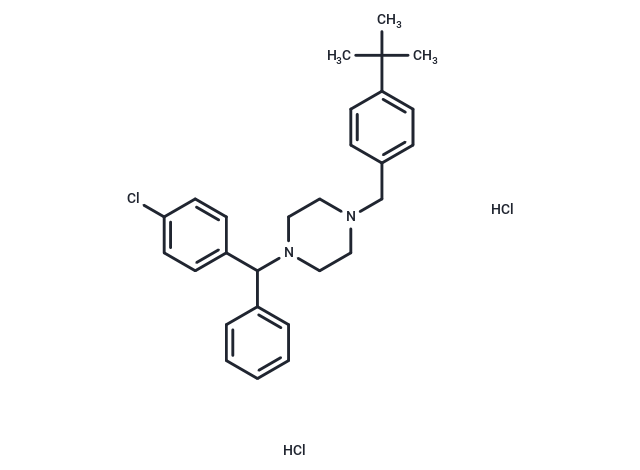- Remove All
 Your shopping cart is currently empty
Your shopping cart is currently empty
Shopping Cart
Buclizine dihydrochloride
Catalog No. T6426Cas No. 129-74-8
Alias UCB-4445, Longifene, Buclizine HCl, Buclina
Buclizine dihydrochloride (Buclina) is the hydrochloride salt form of buclizine, a piperazine histamine H1 receptor antagonist with primarily antiemetic and antivertigo activities. Buclizine dihydrochloride binds to and blocks the histamine H1 receptor, thereby preventing the symptoms that are caused by histamine activity. Buclizine dihydrochloride exerts its anti-emetic effect by binding to and blocking the muscarinic and histamine receptors in the vomiting center of the central nervous system (CNS). This may prevent activation of the chemoreceptor trigger zone (CTZ) and may reduce nausea and vomiting.

Buclizine dihydrochloride
Catalog No. T6426Alias UCB-4445, Longifene, Buclizine HCl, BuclinaCas No. 129-74-8
Buclizine dihydrochloride (Buclina) is the hydrochloride salt form of buclizine, a piperazine histamine H1 receptor antagonist with primarily antiemetic and antivertigo activities. Buclizine dihydrochloride binds to and blocks the histamine H1 receptor, thereby preventing the symptoms that are caused by histamine activity. Buclizine dihydrochloride exerts its anti-emetic effect by binding to and blocking the muscarinic and histamine receptors in the vomiting center of the central nervous system (CNS). This may prevent activation of the chemoreceptor trigger zone (CTZ) and may reduce nausea and vomiting.
| Pack Size | Price | Availability | Quantity |
|---|---|---|---|
| 50 mg | $30 | In Stock | |
| 100 mg | $42 | In Stock | |
| 200 mg | $55 | In Stock | |
| 1 mL x 10 mM (in DMSO) | $45 | In Stock |
Bulk & Custom
Add to Cart
Questions
View MoreSelect Batch
Purity:98.05%
Contact us for more batch information
All TargetMol products are for research purposes only and cannot be used for human consumption. We do not provide products or services to individuals. Please comply with the intended use and do not use TargetMol products for any other purpose.Product Introduction
Bioactivity
Chemical Properties
| Description | Buclizine dihydrochloride (Buclina) is the hydrochloride salt form of buclizine, a piperazine histamine H1 receptor antagonist with primarily antiemetic and antivertigo activities. Buclizine dihydrochloride binds to and blocks the histamine H1 receptor, thereby preventing the symptoms that are caused by histamine activity. Buclizine dihydrochloride exerts its anti-emetic effect by binding to and blocking the muscarinic and histamine receptors in the vomiting center of the central nervous system (CNS). This may prevent activation of the chemoreceptor trigger zone (CTZ) and may reduce nausea and vomiting. |
| In vitro | Buclizine hydrochloride, a piperazine derivative, is a sedating antihistamine with antimuscarinic and moderate sedative action. Buclizine is used in the prevention and treatment of nausea, vomiting, and dizziness associated with motion sickness. Additionally, it has been used in the management of vertigo in diseases affecting the vestibular apparatus. Although the mechanism by which buclizine exerts its antiemetic and antivertigo effects has not been fully elucidated, its central anticholinergic properties are partially responsible. The drug depresses labyrinth excitability and vestibular stimulation, and it may affect the medullary chemoreceptor trigger zone. It also possesses anticholinergic, antihistaminic, central nervous system depressant, and local anesthetic effects. [1] |
| Kinase Assay | Topoisomerase I Catalytic Actioity Assay [1]: Topoisomerase I Catalytic Actioity Assay: The enzymatic activity is analyzed by the DNA unwinding assay. DNA topoisomerase I, from TopoGEN (1 unit, which is defined as the amount of enzyme that converts 0.5 μg of superhelical DNA to the relaxed state in 30 minutes at 37 °C), is incubated with 0.5 μg of 6x174 RF DNA, in the presence or absence of Beta-Lapachone, in 20 μL of relaxation buffer (50 mM Tris (pH 7.5). 50 mM KCI, 10 mM MgCl2, 0.5 mM dithiothreitol, 0.5 mM EDTA, 30 μg/mL bovine serum albumin) for 30 minutes at 37 °C. Reactions are stopped by adding 1% SDS and proteinase K (50 μg/mL). After an additional 1-hour incubation at 37 °C, the products are separated by electrophoresis in 1% agarose gel in TAE buffer (0.04 M tris acetate, 0.001 M EDTA). The gel is stained with ethidium bromide after electrophoresis. The photographic negative is scanned with an NIH image analysis system. |
| Alias | UCB-4445, Longifene, Buclizine HCl, Buclina |
| Molecular Weight | 505.95 |
| Formula | C28H33ClN2·2HCl |
| Cas No. | 129-74-8 |
| Smiles | CC(C)(C)c1ccc(cc1)CN1CCN(CC1)C(c1ccccc1)c1ccc(cc1)Cl.Cl.Cl |
| Relative Density. | no data available |
Storage & Solubility Information
| Storage | Powder: -20°C for 3 years | In solvent: -80°C for 1 year | Shipping with blue ice. | |||||||||||||||||||||||||
| Solubility Information | DMSO: 11 mg/mL (21.74 mM), Sonication is recommended. | |||||||||||||||||||||||||
Solution Preparation Table | ||||||||||||||||||||||||||
DMSO
| ||||||||||||||||||||||||||
Calculator
In Vivo Formulation Calculator (Clear solution)
Please enter your animal experiment information in the following box and click Calculate to obtain the mother liquor preparation method and in vivo formula preparation method:
Mother liquor preparation method: 2 mg of drug dissolved in 50 μL DMSO (mother liquor concentration of 40 mg/mL), if you need to configure a concentration that exceeds the solubility of the product, please contact us first.
(mother liquor concentration of 40 mg/mL), if you need to configure a concentration that exceeds the solubility of the product, please contact us first.
Preparation method for in vivo formula: Take 50 μL DMSO main solution, add 300 μLPEG300
main solution, add 300 μLPEG300 mix well and clarify, then add 50 more μL Tween 80, mix well and clarify, then add 600 more μLddH2O
mix well and clarify, then add 50 more μL Tween 80, mix well and clarify, then add 600 more μLddH2O mix well and clarify
mix well and clarify
For Reference Only. Please develop an appropriate dissolution method based on your laboratory animals and route of administration.
Dose Conversion
You can also refer to dose conversion for different animals. More Dose Conversion
Tech Support
Please see Inhibitor Handling Instructions for more frequently ask questions. Topics include: how to prepare stock solutions, how to store products, and cautions on cell-based assays & animal experiments, etc
Keywords
Related Tags: buy Buclizine dihydrochloride | purchase Buclizine dihydrochloride | Buclizine dihydrochloride cost | order Buclizine dihydrochloride | Buclizine dihydrochloride chemical structure | Buclizine dihydrochloride in vitro | Buclizine dihydrochloride formula | Buclizine dihydrochloride molecular weight

Copyright © 2015-2025 TargetMol Chemicals Inc. All Rights Reserved.



